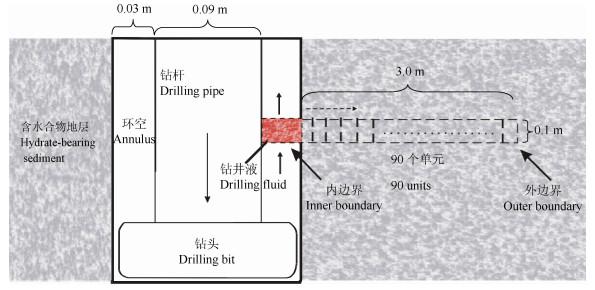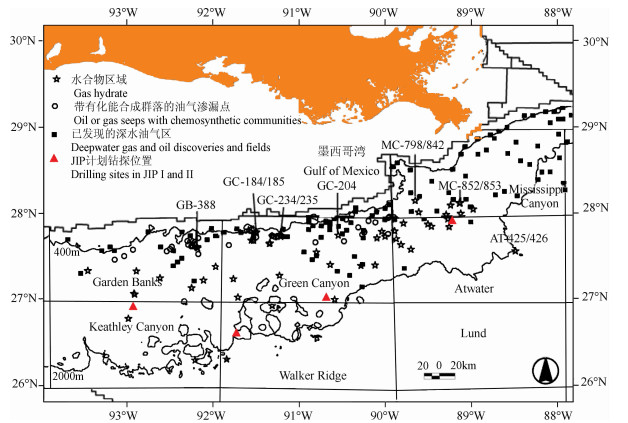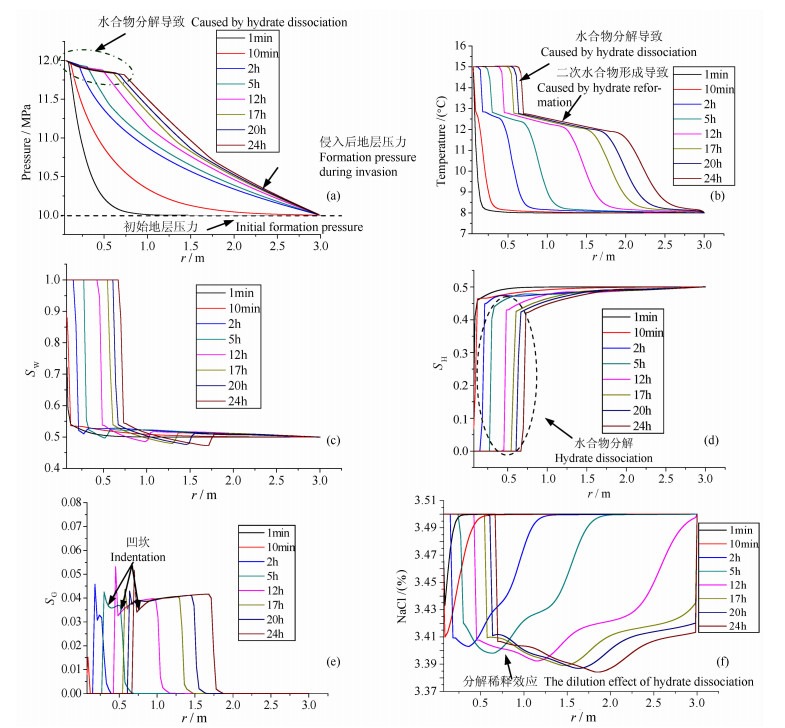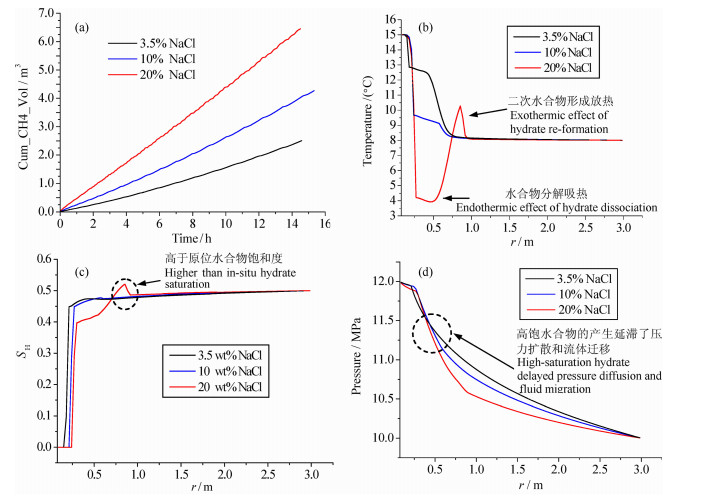2. 美国劳伦斯伯克利国家实验室, 伯克利 94720;
3. 北京师范大学水科学研究院, 北京 100875;
4. 中国科学院广州天然气水合物研究中心, 广州 510640
2. Earth System Division, Lawrence Berkeley National Laboratory, Berkeley 94720, U.S.A;
3. College of Water Sciences, Beijing Normal University, Beijing 100875, China;
4. Guangzhou Centre of Gas Hydrate Research, CAS, Guangzhou 510640, China
气体水合物是由水分子和气体小分子(分子直径 < 0. 9 nm)在低温(通常是不到300 K)和高压(一般大于3. 8 MPa)条件下接触而形成的非化学计量的笼状结晶化合物[1].作为主体的水分子通过氢键网络形成笼形结构包裹住作为客体的气体小分子,后者通常为疏水的天然气分子,典型的如甲烷和二氧化碳气体,这些客体小分子通过范德华力维持“笼子”的稳定[2-3].因而,气体水合物通常也称为天然气水合物,或简称水合物.自从上世纪60年代中期和80年代早期分别在永久冻土带[4]和海洋区域[5]发现水合物以来,其在资源、环境和全球气候变化中的重要意义引起了各国政府、各大油气公司和各类学术研究机构的极大关注,成为当前地球科学和能源研究的一大热点.特别是进人21世纪以来,随着油气资源可采量的减少和消耗量的增加,天然气水合物等非常规能源的勘探与开发被正式提上了议事日程.据Klauda和Sandler[6]估计,仅海域水合物里就储存有74000Gt的甲烷,是全世界常规天然气存量的3个数量级大,可见其资源量之丰富.因此,海洋水合物勘探与开发是现今及未来研究的重点.
目前常用的海洋水合物勘探方法主要有地质(如海底麻坑、泥火山、地质微生物方法等)、地球物理、地球化学和钻探取心.地球物理方法应用最广泛[7],包括地震技术[8]、测井技术[9]和最新式的海洋电磁技术[10],而钻探取心则是识别和评价海洋水合物储层最直接的方式.迄今为止,海洋水合物钻探及相应的地球物理测井活动主要发生在布莱克海岭(Blake Ridge)[11]、卡斯凯迪亚大陆边缘的水合物岭(Hydrate Ridge)[12]、墨西哥湾[13]、日本南海海槽[14]、中国南海北部陆坡[15]、印度大陆边缘[16]、韩国东海郁陵盆地[17]等地区.尽管取得了巨大技术进步和丰硕成果,但是仍然有三朵“乌云”笼罩在当前海洋水合物勘探开发的天空上:诸层定量描述不足,开采技术不过关和开发应用风险不小.而后者就是指勘探开发过程中引发的钻井安全(如井壁失稳)、地质灾害、气候环境影响等问题.由于海域水合物地层压实固结程度较差[18-19],在钻探过程中若采用欠平衡钻井方式,则不利于井壁力学稳定.而且水合物还会在减压下分解,导致地层力学强度急剧降低[20-21],越发不利于井壁稳定和井内安全.因此,维持孔内压力大于地层孔隙压力(但不高于破裂压力)是水合物钻井较为可取的安全方式[22].在此条件下,钻井液(这里指水基钻井液)在水力压差的作用下驱走井壁周围地层孔隙中的原生流体(气、水)而侵入地层(图 1).钻井实践证明,钻井液侵入会改变井壁围岩特性,比如岩石强度、孔隙压力等[23].与钻井液侵入常规油气地层所不同的是,受钻具摩擦生热以及钻井液温度影响,钻井液侵入含水合物地层过程中还可能伴随有水合物的分解,从而加速井壁失稳.此外,在众多的地球物理测井属性中,电阻率和波速受水合物的影响最突出[9].由于海洋区域水合物赋存在固结性差的沉积物中,而声波受压实系数的影响较重,因此电阻率测井又比声波测井和其他测井方法更稳定和可靠[24-25].但是,钻井过程中钻井液循环和侵入却对电阻率测井有着显著的影响[26].比如为抑制水合物在井内形成和保护海洋环境,深水油气和水合物钻井通常采用高盐聚合物水基钻井液体系[27],当高矿化度钻井液滤液侵入时会严重影响储层特征和电阻率测井准确性.而且盐是热力学抑制剂,其随钻井液侵入会使水合物相平衡曲线向左迁移,导致地层中水合物分解,进一步影响测井识别评价、井周地层稳定和井内安全.因此,研究耦合有水合物分解的水基钻井液侵入含水合物地层的动态特性及其对地层的影响规律对水合物安全快速钻井、测井准确识别和评价、水合物储层保护、水合物资源和环境评估以及大洋综合钻探计划孔内水合物动态观测系统实施都具有重要意义和应用价值.

|
图 1 钻井液侵入含水合物沉积地层示意图 Fig. 1 chematic diagram of invasion of drilling fluid into gas hydrate bearing sediment |
在过压钻井条件下,钻井液温度和盐度就成为侵入过程中地层水合物稳定与否的主要因素.若钻井液温度低于相应盐度和压力条件下的水合物相平衡温度(图 2A点),则钻井液在水合物地层的侵入与在常规油气地层中的侵入机理类似.由于海洋水合物稳定区域地层温度要比相应冻土区高,且原位状态点(温度和压力)离相平衡线更近(如南海神狐海域,水合物地层温压状态就在相平衡边界附近[28]),加之钻具摩擦生热和钻井液中的热力学抑制剂存在,常导致钻井液温度高于相应压力条件下的水合物相平衡温度(图 2B点),使得井周水合物发生分解,因此耦合有水合物分解的钻井液侵入含水合物地层是海洋水合物勘探开发钻井中可能常遇到的情况.

|
图 2 钻井液温度和水合物地层温度关系图 Fig. 2 The possible relations between the temperature of drilling fluid and the temperature of hydrate reservoirs |
如果忽略次要因素,钻井液侵入水合物地层主要表现为压差下钻井液驱替渗入水合物地层和温差(此温差是钻井液温度与相应条件下水合物相平衡温度之间的差异而非钻井液温度与地层温度之间的差异)下水合物被加热分解.由此,耦合水合物分解的钻井液侵入过程也可近似描述为流动方向相反的水合物储层加热开采过程,从而可利用现有的水合物开采数值模型进行研究,只不过前者作用范围小,仅限于井眼周围一个有限的环形区[29],水合物分解也只在井周一定范围内进行.据此,在前期工作基础上[30-31],以墨西哥湾水合物区域为背景,利用劳伦斯伯克利国家实验室开发的水合物开采数值模拟软件TOUGH+HYDRATE[32]分析了一定条件下钻井液侵入海洋水合物储层的动态过程及其对地层的影响规律.
2 数值模型 2.1 模拟方法TOUGH+HYDRATE软件主要用于海洋和冻土地区天然气水合物的开采模拟研究[33-35],它还可与其它软件如FLAC3D耦合用于模拟钻井开采水合物过程中的井壁稳定以及储层变形等[36-37].该软件模型是在通用地下水渗流模拟计算程序(TOUGHV2. 0)的基础上结合水合物状态方程(EOSHYDR)发展而来,模拟计算过程中,每次分步计算中的初始状态都是基于前一次分步计算的结果.模型包括水合物形成和分解的平衡和动力学两种模式,考虑四相(气、液、冰、水合物)、四组分(水合物、水、甲烷、盐等水溶性抑制剂),各组分存在于各相中[32],可模拟降压、注热、加入抑制剂条件下的水合物分解反应、相行为以及相应储层流体的传热传质作用[38].本文研究采用水合物形成和分解的平衡模式,不考虑化学力学耦合,忽略扩散作用,钻井液中只含热力学抑制剂NaCl.同时假设水合物均匀分布在孔隙中,地层各向同性,从而使侵入问题简化为一个一维平面径向多相流驱替问题.其中控制侵入过程传热传质特性的关键参数方程主要有地层相对渗透率、毛管力、导热系数和孔隙压力,在本文模拟中采用的相应计算方程如下:
1)相对渗透率模型[39]为

|
(1) |
式(1)中,krA为液相相对渗透率; krG为气相相对渗透率; SA为液相饱和度SG为气相饱和度;SirA为束缚水饱和度,取值为0.1;SirG为束缚气饱和度,取值为0. 01;n=nG=3. 4.
毛管压力计算公式为[40]

|
(2) |
式(2)中,Pcap为毛管压力;λ取值0. 77437;SirA取值0.095;SxmA为最大液相饱和度,取值为1.0;P0为初始压力,取值为103Pa,Pmax=106Pa.
地层综合导热系数λc计算公式为[41]

|
(3) |
式(3)中,SH为水合物饱和度;λHs只含水合物的沉积地层导热率,λs为水饱和沉积地层导热率;海洋环境下地层内无冰出现,因此SI=0.
由于水合物分布在未固结的沉积物中,且距海底近,因此可认为孔隙水相互连通并与底层水相连,沉积物中孔隙水压力即为静水压力[42],从而可用下面经验公式计算孔隙水压力[7]:

|
(4) |
式⑷中,Ppw为孔隙水压力,MPa; Patm为大气压,其值为0. 101325 MPa; h为水深;z为海底沉积物距海底的深度;h和z的单位为m,g为重力加速度,ρsw为平均海水密度,是水深、温度和盐度的函数,通常可取1035 kg/m3[35].
水合物相平衡模型[43]

|
(5) |
式(5)为Lw-H-V三相平衡时温度和压力拟合关系式,Pe为水合物相平衡压力,MPa; Te为平衡温度,K.
2.2 模拟参数采用轴对称的圆柱坐标系,钻孔位于圆柱中心处,取钻孔直径为150 mm,钻杆直径取90 mm,环空间隙为30 mm.由于泥浆侵入作用范围小,仅限于井眼周围一个有限的环形区域[29],因此取井径的20倍即3 m作为井周研究范围.由于假设地层均质,因此在水合物层中间位置取一厚度为0.1 m的薄层做为研究对象,沿径向剖分成90个单元.钻孔环空中相应区域的泥浆被划分为一个单元格,并设成固定内边界,即温度和压力保持恒定(图 3).

|
图 3 钻探过程中钻井液侵入水合物地层模型示意图 Fig. 3 Schematic of drilling fluid invasion during drilling in the hydrate-bearing sediment |
墨西哥湾北部陆坡是现今海洋水合物勘探开发的热点地区之一[44],特别是美国能源部(DOE)和雪佛龙石油公司(Chenon)联合主导实施了两个阶段的墨西哥湾水合物联合工业计划(简称JIP I和JIP II)取得了丰硕的成果(图 4)[13].该区域水合物主要分布在水深500〜2000 m的海底[45-46],一般赋藏于海底2 m以下的沉积层.水合物饱和度变化也很大[46],如在JIP Ⅱ钻探取心航次中就发现砂岩中水合物饱和度范围在50%〜90%之间[47].据此,模拟中选取的水合物初始饱和度为50%.根据墨西哥湾已有地球物理和钻探取心资料,设定水合物层温度为8 ℃,海水深度为800 m,水合物层距海底176 m.根据公式(4)算得该处压力约为10 MPa,满足此盐度条件下水合物形成和稳定的温压条件[13].实际海洋水合物钻井中,通常选用海水造浆,因此盐含量与地层孔隙水盐度相同,取3. 5%,并假定全部是NaCl.钻井液密度设为1250 kg/m3,则计算出侵入处井内压力约为12MPa侵入处钻井液温度设为15℃,海底饱和水沉积物导热系数λs取3.1 W·m-1·℃-1,只含水合物沉积物层导热系数λHs取0.8 5 W·m-1·℃-1.水合物层孔隙中只包含两相,分别是水合物相和水相,其中水合物的初始饱和度SH为50%,水的饱和度Sw为50%.水合物层中的海底沉积物密度ρ取2600k g /m3.水合物层的孔隙度Φ取3 5%.由于缺乏墨西哥湾水合物区域沉积物绝对渗透率参数实测值,此处借鉴常规砂岩地层K取2.9 6×1 0-13m2.其它未说明参数则根据文献[28]和[35]取值.主要地层物理性质和参数见表 1.

|
图 4 墨西哥湾北部浅水和深水区域水合物分布及JIP计划钻探位置图[46, 48] Fig. 4 Map showing the distribution of gas hydrate sites in the northern Gulf of Mexico (modified from[46, 48]) |
|
|
表 1 模拟采用的参数值 Table 1 Parameters of formation and drilling fluid in simulations |
图5 a-c表明当井眼打开后,钻井液迅速渗入井壁,驱替地层原有流体和固体颗粒,导致井壁附近地层孔隙压力、温度、含水量迅速增加.同时井壁附近水合物受热分解成水和气(图5 d),也即侵入过程中还伴随有相变行为,这是与钻井液侵入常规油气地层的主要区别.井壁附近(图 5c中距井壁0.75 m内)含水量高达100%是因为此区域内水合物已完全分解,从而使得孔隙空间完全被侵入钻井液和分解产生的水所填充.随后区域含水量会急剧降低,甚至低于初始含水饱和度(50%),这是因为水合物还在分解,而侵入驱替导致气体饱和度增加,从而使得相应的含水饱和度降低(可对比图 5c、图d和图 5 e 12 h后的曲线).图 5a和图 5b还表明,随着时间的推移,钻井液侵入量增多,温度和压力逐渐向四周传递.在开始阶段地层压差较大,随着压力扩散,曲线变缓.在井周附近(图 5 a距井壁1m内),由于水合物分解剧烈,分解程度高,产生的水气导致孔隙压力比没有水合物分解时高[49].而水合物分解也导致地层渗透性变好,从而使得压力扩散容易,压力分布曲线变缓,也即意味着水合物分解使得钻井液侵入导致的孔隙压力增加幅度值比侵入常规油气地层的高.孔隙压力增大会使骨架应力降低,使地层抵抗破坏的能力下降,井壁也就容易失稳.而且水合物分解还会急剧降低井壁围岩力学强度,使地层抵抗破坏的能力下降[20-21, 50],从而加剧井壁失稳风险.特别是在近井壁区域,由于受井内温度扰动大,水合物分解比较剧烈,孔隙压力增加程度高,相应也是井壁最脆弱的地带.因此,耦合水合物分解的钻井液侵入水合物地层会带来比常规海洋深水钻井作业更大的井壁失稳问题.而在离井壁较远处(图 5c中1 m之外),由于水合物分解程度低,使得孔隙压力扩散规律与常规地层侵入类似.随着时间的推移,水合物分解程度逐渐增加,井周水合物分解前缘逐渐向地层深处推进(图 5 d).开始分解的气量少,都溶解在孔隙水中,随着分解程度增加,游离气量逐渐提高(图 5 e).同时分解也会稀释地层孔隙水盐度,使得矿化度降低,加之分解的游离气体和重新形成的水合物导致在井周存在一个“较高电阻”环带(“较高”是相比较于原始地层电阻率来说,如图 5 d -f中距井壁1.8 m范围内.尽管近井周水合物饱和度降低会相对降低此区域电阻率值,但是分解产生的游离气又会使此区域电阻率升高并超过水合物饱和度降低的影响,因此整体电阻率仍变大[51].也即在地层离子总数一定的条件下,水合物分解稀释作用并不是控制地层高视电阻率的主要因素,分解产生的游离气体对地层电阻率影响很大.此外由于水合物分解是吸热反应,因此导致井周1 m内地层温度急剧降低(图 5 b).从图 5 e还可以发现,侵入导致的孔隙压力升高和水合物分解吸热导致的温度降低(其中还耦合有节流降温效应)以及传热滞后又使得部分分解的气体与孔隙水反应在地层某一位置重新形成水合物(常称为“二次水合物”[52-53]),使含气量降低一定值,在相应含气饱和度分布图上表现为若干“凹坎”.其实钻井液侵入导致的二次水合物形成机理类似于用天然气注入含水合物岩心测试其渗透性,后者在实验中发现有额外水合物形成[54].此外,水合物分解导致的孔隙水盐度的降低也有利于二次水合物形成[53].而水合物形成属于放热反应,因此导致温度曲线放缓,即温度降低趋势变缓,如图 5b所示.总的来看,在模拟条件下,24h后井周0. 65 m左右的范围内已基本无水合物存在,而此时二次水合物形成位置大约在0.7〜1.0 m范围内(图 5d -e).

|
图 5 侵入过程中不同时刻井周地层物性参数变化规律(a)不同时刻井周地层压力分布图;(b)不同时刻井周地层温度随时间变化规律;(c)不同时刻井周液态水量分布;(d)不同时刻井周水合物饱和度分布;(e)不同时刻井周含气饱和度分布;(f)不同时刻井周盐度分布. Fig. 5 The variation of physical properties of sediment around the borehole as a function of distance during mud invasion (a)The distribution of pore pressure around borehole; (b)The distribution of temperature around borehole; (c)The distribution of water saturation around borehole; (d)The distribution of hydrate saturation around borehole; (e)The distribution of free gassaturation around borehole; (f)The distribution of NaCl concentration around borehole. |
在海洋常规油气或水合物钻井活动中,保证钻井安全比如防止井壁失稳和井涌甚至井喷的常规做法是增加钻井液密度,即增加井内压力.井内压力的增加会使井内和地层水力压差变大从而影响钻井液侵入.在同等温度和钻井液盐度条件下,模拟改变钻井液密度到1560 kg/m3, 即侵入处压力约为15 MPa,可以发现,钻井液密度越大,侵入越深,热量传递越快越远,导致整体水合物分解程度越大(图 6a)剩余水合物量越少.而压力高时,会加快近井壁地层压力扩散,从而消除部分水合物分解产生的孔隙压力增加的影响.此外,压力高也会一定程度上减缓井周附近水合物分解速度,使得温度降低程度较小,而高压力也会促使更多的分解气体重新形成水合物,因而温度升高程度更大(图 6b).高压力也会增加孔隙水中的气体溶解量,加之更多二次水合物的形成,从而使得地层中无游离气存在(图 6c).此外,压力越高,整体水合物分解程度越大,水合物分解稀释作用范围越宽(图 6d).因此,若钻井液温度高于水合物相平衡稳定温度,为更好地维持井壁稳定和保证测井准确性,应控制钻井液密度在合适范围内,而不是越大越好,否则不仅会有压裂地层的风险,反而还会增加井壁失稳(因水合物分解程度增加)和测井失真(因水合物分解稀释作用)概率,最好是采用控制压力钻井(MPD)方式.

|
图 6 不同钻井液密度侵入条件下井周地层物性径向分布规律(a)不同钻井液密度条件下井周地层水合物饱和度分布(t=2 h);(b)不同钻井液密度条件下井周地层温度分布(t=2 h);(c)不同钻井液密度条件下井周地层游离气含量分布(t=2 h);(d)不同钻井液密度条件下井周地层水盐度分布(t=2 h). Fig. 6 The distribution of physical properties of sediment around borehole under the invasion conditions of different mud densities (a)The distribution of hydrate saturation around borehole(t=2 h); (b)The distribution of temperature around borehole(t=2 h); (c)The distribution of free gas saturation around borehole(t=2 h); (d)The distribution of NaCl concentration around borehole(t=2 h). |
在研究钻井液侵入常规油气地层时,通常将这一过程视为等温侵入[55],即忽略钻井液温度对其影响[23].但是在水合物地层,由于有相变的存在,需要考虑温度效应.模拟发现,在同等压力和钻井液盐度条件下,当高于水合物稳定温度时,钻井液温度越高水合物分解程度越大(图 7a -b),侵入的影响深度越远(图 7b-c).钻井液侵入的驱替推挤作用使得分解的气体和水向地层深处聚集并相应地使孔隙水压力升高,而水合物分解吸热导致的地层降温加之传热的滞后等因素共同作用又导致分解的气体和孔隙水重新在地层某处形成二次水合物.二次水合物加上原始未分解完水合物使得该区域水合物饱和度甚至高于原位水合物饱和度,即形成一个“高饱水合物环”图 7b,图 7d)相应在含水量分布上存在一个“低饱环”图 7c).钻井液与地层温差越大时,此特征越明显,形成的二次水合物饱和度越大,环的范围越宽.而高饱水合物的形成,也降低了地层渗透性[56],阻碍了钻井液的侵入,延滞了孔隙压力扩散(图 7d-e)导致有更多的气体和水滞留在此区域从而不断形成二次水合物,最终在地层中出现一个水合物饱和度峰值(图 7b,侵入两小时后,此位置大约在距井壁0. 6 m处).可以推测,随着时间推移,这个峰值位置和大小是不断动态迁移的.此外,温度越高,水合物分解产生的水也越多,从而导致孔隙水盐度降低越大,而后续高饱水合物的形成又导致孔隙水盐度急剧升高(图 7f).因此在水合物钻井过程中应严格控制井内温度,尽可能确保钻井液低温循环.

|
图 7 不同钻井液温度侵入条件下井周地层物性径向分布规律(a)不同钻井液温度条件下研究区域累积分解气量;(b)不同钻井液温度条件下井周水合物饱和度分布(t=2 h);(c)不同钻井液温度条件下井周含水量分布(t=2 h);(d)钻井液侵入过程中“高饱水合物环”形成示意图;(e)不同钻井液温度下井周地层压力分布(t=2 h);(f)不同钻井液温度条件下井周盐度分布(t=2 h). Fig. 7 The distribution of physical properties of sediment around the borehole under the invasion conditions of different mud temperatures (a)The accumulative gas from hydrate dissociation; (b)The distribution of hydrate saturation (t=2 h); (c)The distribution of water saturation (t=2 h); (d)The occurrence of high saturation hydrate ring; (e)The distribution of porepressure (t=2 h); (f)The distribution of NaCl concentration (t=2 h). |
在海洋深水油气及水合物钻井时,为改善钻井液性能并防止水合物在井筒或防喷器处形成和聚集,通常会考虑加入较高含量的一些无机盐处理剂比如NaCl和KC1,这些盐类属于热力学水合物形成抑制剂,也即会有有利于水合物分解.图 8a表明在同等条件下,钻井液含盐越高,则钻井液侵入导致水合物分解程度越大.原因其一是盐是热力学抑制剂,导致水合物相平衡曲线向左迁移从而有利于分解; 其二是盐含量的增加也有利于流体传热,因为盐的导热率通常比沉积物高3〜4倍[57].由此导致高盐含量的钻井液具有更好的导热性能,热量能够更快地在钻井液和地层之间传导.所以在图 8b中可以发现水合物分解吸热导致的地层降温和二次水合物形成放热导致的地层升温都很剧烈,曲线表现的很陡.高盐含量的钻井液侵入同样会产生和较高钻井液温度侵入类似的“高饱水合物环带”(图 8c).此外,同样由于二次水合物的形成,延滞了钻井液侵入过程中的压力扩散(图 8d)阻碍了钻井液的持续侵入.盐度越高,这一趋势越明显.尽管水合物分解产生的水对钻井液侵入有一定稀释作用,分解气也会使电阻率升高,但是高盐度钻井液侵入时,仍然最大可能还是表现为“低侵”即在电阻率测井动态响应特征上,表现为侧向视电阻率下降.因此,在海洋水合物地层钻井时,应尽量选用低矿化度的钻井液体系,即少添加会影响井周水合物稳定和测井结果的无机盐类.

|
图 8 不同钻井液盐度侵入条件下井周地层物性径向分布规律(a)不同钻井液盐含量下研究区域累积分解气量;(b)不同钻井液盐含量下井周地层温度分布(t=2h);(c)不同钻井液盐含量下井周水合物饱和度分布(t=2h);(d)不同钻井液盐含量下井周地层压力分布(t=2h). Fig. 8 The distribution of physical properties of sediment around the borehole under the invasion conditions of different mud salinities (a)The accumulative gas from hydrate dissociation; (b)The distribution of temperature(t=2 h); (c)The distribution of hydrate saturatione(t=2 h); (d)The distribution of porepressure(t=2 h). |
上述模拟结果表明在地层物性一定条件下,影响钻井液侵入含水合物地层的主要因素为钻井液密度、温度、盐度和侵入时间.当钻井液温度高于地层中水合物稳定温度时,钻井液侵入会导致井周地层中水合物分解,而分解产生的气体被侵入的滤液驱替推挤从而在地层中一定区域内聚集,侵入导致的孔隙水压力增加、耦合有节流效应的水合物分解吸热降温作用以及地层传热滞后共同导致聚集的气体重新形成水合物.因此钻井液在含水合物地层侵入过程中常耦合有水合物分解以及二次水合物形成,这是与常规油气地层侵入的一个主要区别.甚至在一定条件下形成的二次水合物叠加原位水合物使得该区域内水合物饱和度高于地层原始水合物饱和度,从而在井周形成一个“高饱水合物环带”而水合物分解及其再形成又会反过来改变地层温度和孔隙水压力,进而影响钻井液侵入.因此,钻井液在含水合物地层中的侵入实际上是一个热(钻井液与地层温度差)液(钻井液与地层水力压差导致的侵入)化(水合物分解和再形成)相互耦合的动态过程.
事实上,上述侵入过程还应包括力学耦合.如前所示,水合物分解会极大地降低地层力学强度[20-21, 58].此外,水合物分解和钻井液侵入还会增加井周含水量和孔隙水压力.增加的孔隙水压力通常也被称为过压(overpressure)或者超孔隙压力(excess pore pressure)59-62].根据Bot孔隙介质力学理论[63],孔隙水压力增加会相应降低地层的有效应力从而使井周地层失稳风险增加[58-59].特别是对于那些松软细粒的以泥质含量为主的海洋水合物地层,比如在南海北部陆坡[15]和印度大陆边缘[16]某些水合物储层,钻井液侵人及水合物分解产生的气侵甚至可能压裂地层从而形成裂隙[64-65].因此,耦合有水合物分解的钻井液侵人会带来比在常规油气地层更严重的井壁失稳风险,特别是近井壁区域,如本文模拟案例中的井周0. 65 m范围内.
此外,钻井液在含水合物地层侵人导致的另一个不可忽视的影响是对测井识别与解释的干扰.与冰类似,在电阻率测井解释模型中,地层中的水合物通常被看成不导电组分.因而当有水合物存在时,地层电阻率将明显升高[20, 66-67],在电阻率测井动态响应特征上,表现为较高的视电阻率[9, 68-69].由于目前水合物钻探大部分都是直接采用海水作为钻井液,根据上述模拟结果可以推测,当钻井液温度高于地层中水合物相平衡温度,其侵人可能产生的“高饱水合物环带”、水合物分解稀释作用以及分解产生的游离气体会共同作用导致在井周可能形成一个“高视电阻率环带”这个高视电阻率带会使测井获得的地层电阻率值比实际的大,从而使测井解释结果失真.因而在用下列阿尔奇(Arche)公式[70]或者印度尼西亚(Indonesian)方程[71]估算储层水合物饱和度时,就会产生较大的偏差.
阿尔奇公式为

|
(6) |
印度尼西亚方程为

|
(7) |
式(6)和(7)中,Rw为地层原生水的电阻率,a和m是阿尔奇常数,Φ是孔隙度,n是饱和度指数,Rt是含水合物地层电阻率,Vsh是页岩含量,Rsh是页岩电阻率.显然在其它参数一定条件下,侵人导致的较高地层电阻率Rt会使得计算出的Sw偏小,也即估算的水合物饱和度SH会偏大.在墨西哥湾JIP计划水合物钻探过程中,就发现通过测井估算的水合物饱和度整体都比通过地震数据估算的水合物饱和度高[72],我们推测导致上述水合物饱和度差异的原因之一很可能就是钻井液侵人产生的高电阻率影响.同样,2006年进行的印度国家水合物勘探航次(NGHP-01)中,在Krishna-Godavari盆地也发现利用测井数据并采用常规阿尔奇公式计算得到的水合物饱和度(≥50%)远远高于通过压力岩心分析估算出的水合物饱和度值(≤26%)[67].而2007年在南海神狐海域实施的我国首次海洋水合物钻探计划(GMGS-1)中,也发现浅探测电阻率值比深探测电阻率整体上高约0.3 Ωm.由浅至深,深、浅探测电阻率值呈缓慢上升趋势[73].利用ZK1孔的相关测井数据,采用快速阿尔奇公式和印度尼西亚方程计算出的水合物饱和度值都高于现场孔隙水淡化分析得到的水合物饱和度,尤其是印度尼西亚公式求出的饱和度值大于50 %,而由现场孔隙水淡化分析得到的天然气水合物饱和度一般小于48%[73].除了孔隙度误差、泥质含量计算误差以及参数m和n的选取误差外,很可能还包括测井之前钻井液侵人和水合物分解及再形成导致的地层高电阻率影响.而根据我们的模拟结果,甚至可以推测这一误差超过了前述3个因素.然而当钻井液盐度高于地层盐度很多时,模拟发现钻井液侵人后地层盐度仍然升高,即表现为低电阻率侵人,但是水合物分解和再形成则会一定程度削弱这种影响,最终井周盐度(或矿化度)分布实际上是钻井液盐度、水合物分解和再形成程度的综合结果.因此,钻井液侵人和水合物分解及二次水合物形成对水合物测井响应特征的影响很复杂,使得测井解释难度加大.今后在用测井方法识别和评估海洋水合物资源量时,应当考虑钻井液侵人对测井的影响并进行适当校正.
5 结论和建议利用劳伦斯伯克利国家实验室开发的水合物开采数值模拟软件T0UGH+HYDRATE模拟分析了水基钻井液侵人海洋含水合物地层过程及其对井周地层的影响,初步掌握了在过平衡钻井条件下,当钻井液温度高于地层水合物稳定温度时钻井液侵人含水合物地层的基本特征:
1) 钻井液在含水合物地层中的侵人过程是一个耦合相变的非等温非稳态的驱替渗流和扩散过程,伴随有水合物分解和再形成是钻井液侵人水合物地层与侵人常规油气地层的主要区别.在一定地层物性条件下,钻井液侵人过程中影响井周水合物稳定和二次水合物形成的主要因素为钻井液密度、温度和盐度.钻井液侵人的驱替推挤、耦合节流降温效应的水合物分解吸热以及地层传热滞后等因素共同作用导致分解的气体和孔隙水重新形成水合物并可能高于原位水合物饱和度,形成一个“高饱水合物环带”
2) 在一定地层物性的条件下,“高饱水合物环带”的出现与否主要受钻井液温度和盐度控制.而水合物分解产生的游离气体、水合物分解稀释作用以及“高饱水合物环带”共同作用可能导致在井周形成一个“高视电阻率环带”从而使测井解释结果失真.
3) 水合物地层钻井时,为保证井壁稳定、井内安全和测井准确,应对钻井液温度、密度、盐度和滤失量进行严格控制,防止地层中的水合物大量分解.最好采用控制压力钻井方式(MPD),保持较低的正压差,同时尽量选用低矿化度的含有适量暂堵剂的钻井液体系,即少添加会影响测井结果和水合物稳定的盐类,而适量加人暂堵剂则有利于降低井周地层渗透率,降低钻井液侵人程度.钻井液循环则采取低温快速策略,但是低温有可能导致分解溢出的游离气重新在井内形成水合物并聚集,因此最好向钻井液中加人水合物动力学抑制剂或防聚剂而不是盐类等热力学抑制剂.模拟结果还表明,当钻井条件超过水合物稳定区域时,在水合物地层即使采用随钻测井方式也可能会不准确,因为钻井液侵人和水合物分解很迅速,所以测井时最好停钻较长时间并采用深侧向电阻率测井方式.
总之,钻井液是实现水合物安全钻探和储层精确评估的关键,设计合适的钻井液体系是水合物地层钻井工作中最为重要的一环.后续还需结合实际水合物钻井情况进一步研究钻井液侵人和水合物分解影响范围以及地层物性如渗透性、孔隙度和水合物饱和度对耦合有水合物分解的钻井液侵人的影响规律,从而为今后含水合物地层测井响应识别和反演校正、井壁稳定评估以及储层伤害评价奠定坚实的理论基础.
致谢感谢美国劳伦斯伯克利国家实验室的George Moridis博士和斯伦贝谢石油公司研究员徐文跃博士对本文模型建立和理论分析的指导.
| [1] | Sloan E D. Clathrate hydrate measurements: microscopic, mesoscopic, and macroscopic. The Journal of Chemical Thermodynamics , 2003, 35(1): 41-53. DOI:10.1016/S0021-9614(02)00302-6 |
| [2] | Sloan E D. Fundamental principles and applications of natural gas hydrates. Nature , 2003, 426(6964): 353-359. DOI:10.1038/nature02135 |
| [3] | Moon C, Hawtin R W, Rodger P M. Nucleation and control of clathrate hydrates: insights from simulation. Faraday Discussions , 2007, 136: 367-382. DOI:10.1039/b618194p |
| [4] | Makogon Y F. Peculiarities a Gas-Field Development in Permafrost. Moscow: Nedra, 1966 . |
| [5] | Paull C K, Ussler W, Borowski W S, et al. Methane-rich plumes on the Carolina continental rise-associations with gas hydrates. Geology , 1995, 23(1): 89-92. |
| [6] | Klauda J B, Sandler S I. Global distribution of methane hydrate in ocean sediment. Energy & Fuels , 2005, 19(2): 459-470. |
| [7] | 宋海斌, 江为为, 张文生, 等. 天然气水合物的海洋地球物理研究进展. 地球物理学进展 , 2002, 17(2): 224–229. Song H, Jiang W, Zhang W S, et al. Progress on marine geophysical studies of gas hydrates. Progress in Geophysics (in Chinese) , 2002, 17(2): 224-229. |
| [8] | Riedel M, Spence G D, Chapman N R, et al. Seismic investigations of a vent field associated with gas hydrates, offshore Vancouver Island. Journal of Geophysical Research , 2002, 107(B9): 2200. DOI:10.1029/2001JB000269 |
| [9] | Collett T S. A review of well-log analysis techniques used to assess gas-hydrate-bearing reservoirs. // Paull C K, Dillon W P eds. Natural Gas Hydrates, Occurrence, Distribution and Detection, Geophysical Monograph Series, vol. 124. American Geophysical Union (AGU), 2001, 189-210. |
| [10] | Schwalenberg K, Haeckel M, Poort J, et al. Evaluation of gas hydrate deposits in an active seep area using marine controlled source electromagnetics: Results from Opouawe Bank, Hikurangi Margin, New Zealand. Marine Geology , 2010, 272(1-4): 79-88. DOI:10.1016/j.margeo.2009.07.006 |
| [11] | Paull C K, Matsumoto R, Wallace P J, et al. Proc. ODP, Init. Repts., 164: College Station, TX (Ocean Drilling Program). 1996, doi:10.2973/odp.proc.ir.164.1996. |
| [12] | Tréhu A M, Bohrmann G, Rack F R, et al. Proc. ODP, Init. Repts., 204: College Station, TX (Ocean Drilling Program). 2003, doi:10.2973/odp.proc.ir.204.2003. |
| [13] | Ruppel C, Boswell R, Jones E. Scientific results from gulf of mexico Gas hydrates joint industry project Leg 1 drilling: Introduction and overview. Marine and Petroleum Geology , 2008, 25(9): 819-829. DOI:10.1016/j.marpetgeo.2008.02.007 |
| [14] | Tsuji Y, Ishida H, Nakamizu M, et al. Overview of the MITI Nankai Trough wells: A milestone in the evaluation of methane hydrate resources. Resource Geology , 2004, 54(1): 3-10. DOI:10.1111/rge.2004.54.issue-1 |
| [15] | Zhang H Q, Yang S X, Wu N Y, et al. Successful and surprising results for China's first gas hydrate drilling expedition. Fire in the Ice: Methane Hydrate Newsletter , 2007: 6-9. |
| [16] | Collett T S, Riedel M, Cochran J R, et al. Indian continental margin gas hydrate prospects: results of the Indian National Gas Hydrate Program (NGHP) expedition 01. // The 6th International Conference on Gas Hydrates (ICGH 2008). Vancouver, British Columbia, Canada, 2008. |
| [17] | Ryu B J, Riedel M, Kim J H, et al. Gas hydrates in the western deep-water Ulleung Basin, East Sea of Korea. Marine and Petroleum Geology , 2009, 26(8): 1483-1498. DOI:10.1016/j.marpetgeo.2009.02.004 |
| [18] | Lee M W. Elastic velocities of partially gas-saturated unconsolidated sediments. Marine and Petroleum Geology , 2004, 21(6): 641-650. DOI:10.1016/j.marpetgeo.2003.12.004 |
| [19] | Birchwood R, Singh R, Mese A. Estimating the In Situ Mechanical Properties of Sediments Containing Gas Hydrates. // The 6th International Conference on Gas Hydrates (ICGH 2008). Vancouver, British Columbia, Canada, 2008. |
| [20] | Winters W J, Waite W F, Mason D H, et al. Methane gas hydrate effect on sediment acoustic and strength properties. Journal of Petroleum Science and Engineering , 2007, 56(1-3): 127-135. DOI:10.1016/j.petrol.2006.02.003 |
| [21] | Yun T S, Santamarina J C, Ruppel C D. Mechanical properties of sand, silt, and clay containing tetrahydrofuran hydrate. Journal of Geophysical Research , 2007, 112: B04106. DOI:10.1029/2006JB004484 |
| [22] | 宁伏龙, 蒋国盛, 张凌, 等. 影响含天然气水合物地层井壁稳定的关键因素分析. 石油钻探技术 , 2008, 36(3): 59–61. Ning F L, Jiang G S, Zhang L, et al. Analysis of key factors affecting wellbore stability in Gas hydrate formations. Petroleum Drilling Techniques (in Chinese) , 2008, 36(3): 59-61. |
| [23] | 张建华, 胡启, 刘振华. 钻井泥浆滤液侵入储集层的理计算模型. 石油学报 , 1994, 15(4): 73–78. Zhang J H, Hu Q, Liu Z H. A theoretical model for mud-filtrate invasion in reservoir formations during drilling. Acta Petrolei Sinica (in Chinese) , 1994, 15(4): 73-78. |
| [24] | Lee M W, Collett T S. Integrated analysis of well logs and seismic data to estimate gas hydrate concentrations at Keathley Canyon, Gulf of Mexico. Marine and Petroleum Geology , 2008, 25(9): 924-931. DOI:10.1016/j.marpetgeo.2007.09.002 |
| [25] | Lee M W, Collett T S. Unique problems associated with seismic analysis of partially gas-saturated unconsolidated sediments. Marine and Petroleum Geology , 2009, 26(6): 775-781. DOI:10.1016/j.marpetgeo.2008.07.009 |
| [26] | 邓少贵, 李智强, 范宜仁, 等. 斜井泥浆侵入仿真及其阵列侧向测井响应数值模拟. 地球物理学报 , 2010, 53(4): 994–1000. Deng S G, Li Z Q, Fan Y R, et al. Numerical simulation of mud invasion and its array laterolog response in deviated wells. Chinese J. Geophys (in Chinese) , 2010, 53(4): 994-1000. |
| [27] | Ebeltoft H, Yousif M, Soergard E. Hydrate control during deepwater drilling: Overview and new drilling-fluids formulations. SPE Drilling & Completion , 2001, 16(1): 19-26. |
| [28] | Ning F L, Wu N Y, Jiang G S, et al. A method to use solar energy for the production of Gas from Marine Hydrate-Bearing sediments: A case study on the Shenhu Area. Energies , 2010, 3(12): 1861-1879. DOI:10.3390/en3121861 |
| [29] | 黄隆基, 石玉江. 含气储集层泥浆侵入的动力学特征及其对补偿中子和补偿密度测井响应的影响. 地球物理学报 , 1998, 41(6): 856–864. Huang L J, Shi Y J. Dynamic characteristics of mud invasion and the effects on responses of compensated density and neutron logs to gas reservoir. Chinese J. Geophys (in Chinese) , 1998, 41(6): 856-864. |
| [30] | Ning F L, Jiang G S, Zhang L, et al. Analysis on Characteristics of Drilling Fluids Invading into Gas Hydrates-Bearing Formation. // Proceedings of the 6th International Conference on Gas Hydrates (ICGH 2008). Vancouver, British Columbia, Canada, 2008. |
| [31] | Ning F L, Wu N Y, Jiang G S, et al. The Effect of Gas Hydrates Dissociation and Drilling Fluids Invasion Upon Borehole Stability in Oceanic Gas Hydrates-Bearing Sediment. American Geophysical Union, Fall Meeting 2009. San Francisco, California, 2009. |
| [32] | Moridis G J, Kowalsky M B, Pruess K. TOUGH+HYDRATE v1.1 User's Manual: A Code for the Simulation of System Behavior in Hydrate-Bearing Geologic Media. Berkeley, California: Lawrence Berkeley National Laboratory University of California, 2009. |
| [33] | Moridis G J, Kowalsky M B, Pruess K, et al. Depressurization-induced gas production from class 1 hydrate deposits. Spe Reservoir Evaluation & Engineering , 2007, 10(5): 458-481. |
| [34] | Moridis G J, Reagan M I, Kim S J, et al. Evaluation of the Gas production potential of marine hydrate deposits in the ulleung basin of the Korean East Sea. SPE Journal , 2009, 14(4): 759-781. DOI:10.2118/110859-PA |
| [35] | Li G, Moridis G J, Zhang K, et al. Evaluation of Gas production potential from marine Gas hydrate deposits in Shenhu Area of South China Sea. Energy & Fuels , 2010, 24(11): 6018-6033. |
| [36] | Rutqvist J, Moridis G J, Grover T, et al. Geomechanical response of permafrost-associated hydrate deposits to depressurization-induced gas production. Journal of Petroleum Science and Engineering , 2009, 67(1-2): 1-12. DOI:10.1016/j.petrol.2009.02.013 |
| [37] | Rutqvist J, Grover T, Moridis G J. Coupled Hydrologic, Thermal and Geomechanical Analysis of Well Bore Stability in Hydrate-Bearing Sediments. Offshore Technology Conference. Houston, Texas, 2008. |
| [38] | Zhang K, Moridis G J, Wu Y S, et al. A domain decomposition approach for large-scale simulations of flow processes in hydrate-bearing geologic media. // Proceedings of the 6th International Conference on Gas Hydrates (ICGH 2008). Vancouver, British Columbia, Canada, 2008. |
| [39] | Stone H. Probability model for estimating three-phase relative permeability. Journal of Petroleum Technology , 1970, 22(2): 214-218. DOI:10.2118/2116-PA |
| [40] | van Genuchten M T. A closed-form equation for predicting the hydraulic conductivity of unsaturated soils. Soil Sci. Soc. Am. J , 1980, 44(5): 892-898. DOI:10.2136/sssaj1980.03615995004400050002x |
| [41] | Moridis G J, Seol Y, Kneafsey T J. Studies of reaction kinetics of methane hydrate dissocation in Porous Media. // The 5th International Conference on Gas Hydrate (ICGH 2005). Trondheim, Norway, 2005. |
| [42] | Hyndman R D, Foucher J P, Yamano M, et al. Deep sea bottom-simulating-reflectors: calibration of the base of the hydrate stability field as used for heat flow estimates. Earth and Planetary Science Letters , 1992, 109(3-4): 289-301. DOI:10.1016/0012-821X(92)90093-B |
| [43] | Moridis G J. Numerical studies of gas production from methane hydrates. Society of Petroleum Engineers Journal , 2003, 8(4): 359-370. |
| [44] | 陈多福, 王茂春, 徐文新, 等. 墨西哥湾西北陆坡天然气水合物资源评价. 海洋地质动态 , 2003, 19(012): 14–17. Chen D F, Wang M C, Xu W X, et al. Assessment of resources and economic potential of gas hydrate in the northwestern Gulf of Mexico Continental Slope. Marine Geology Letters (in Chinese) , 2003, 19(012): 14-17. |
| [45] | Milkov A V, Sassen R. Estimate of gas hydrate resource, northwestern Gulf of Mexico continental slope. Marine Geology , 2001, 179(1-2): 71-83. DOI:10.1016/S0025-3227(01)00192-X |
| [46] | Milkov A V, Sassen R. Preliminary assessment of resources and economic potential of individual gas hydrate accumulations in the Gulf of Mexico continental slope. Marine and Petroleum Geology , 2003, 20(2): 111-128. DOI:10.1016/S0264-8172(03)00024-2 |
| [47] | DOE Expedition Discovers the First Gulf of Mexico Resource-Quality Gas Hydrate Deposits. see alos:http://www.fossil.energy.gov/news/techlines/2009/09028-DOE_Discovers_Hydrate_Deposit.html. |
| [48] | Sassen R, Joye S, Sweet S T, et al. Thermogenic gas hydrates and hydrocarbon gases in complex chemosynthetic communities, Gulf of Mexico continental slope. Organic Geochemistry , 1999, 30(7): 485-497. DOI:10.1016/S0146-6380(99)00050-9 |
| [49] | Xu W Y. Modeling dynamic marine gas hydrate systems. American Mineralogist , 2004, 89(8-9): 1271-1279. DOI:10.2138/am-2004-8-916 |
| [50] | Winters W J, Dallimore S R, Collett T S, et al. Physical properties of sediments from the JAPEX/JNOC/GSC Mallik 2L-38 gas hydrate research well. Geological Survey of Canada Bulletin , 1999, 544: 95-100. |
| [51] | Lee J Y. Physical property measurements of marine gas hydrate-bearing sediments during lab-scale test production. // 2nd Gordon Research Conference on Natural Gas Hydrate Systems. Ventura, California, U. S. A, 2012. |
| [52] | Moridis G J, Reagan M T. Gas Production From Oceanic Class 2 Hydrate Accumulations. Offshore Technology Conference. Houston, Texas, 2007. |
| [53] | Seol Y, Myshakin E. Experimental and numerical observations of hydrate reformation during depressurization in a Core-Scale reactor. Energy & Fuels, 2011, 25(3): 1099-1110. |
| [54] | Johnson A, Patil S, Dandekar A. Experimental investigation of gas-water relative permeability for gas-hydrate-bearing sediments from the Mount Elbert Gas Hydrate Stratigraphic Test Well, Alaska North Slope. Marine and Petroleum Geology , 2011, 28(2): 419-426. DOI:10.1016/j.marpetgeo.2009.10.013 |
| [55] | Bilardo U, Alimonti C, Chiarabelli A, et al. Formation water saturation from drilling fluid filtrate invasion: Comparison of displacement modelling and induction well log response. Journal of Petroleum Science and Engineering , 1996, 15(2-4): 251-259. DOI:10.1016/0920-4105(95)00079-8 |
| [56] | Konno Y, Masuda Y, Takenaka T, et al. Numerical Study on Permeability Hysteresis During Hydrate Dissociation in Hot Water Injection. // Proceedings of the 6th International Conference on Gas Hydrates(ICGH 2008). Vancouver, British Columbia, Canada, 2008. |
| [57] | Nagihara S, Brooks J M, Bernard B B, et al. Application of marine heat flow data important in oil, gas exploration. Oil & Gas Journal , 2002, 100(27): 43-49. |
| [58] | Waite W F, Kneafsey T J, Winters W J, et al. Physical property changes in hydrate-bearing sediment due to depressurization and subsequent repressurization. Journal of Geophysical Research-Solid Earth , 2008, 113: B07102. DOI:10.1029/2007JB005351 |
| [59] | Xu W Y, Germanovich L N. Excess pore pressure resulting from methane hydrate dissociation in marine sediments: A theoretical approach. Journal of Geophysical Research-Solid Earth , 2006, 111: B01104. DOI:10.1029/2004JB003600 |
| [60] | Kwon T H, Cho G C, Santamarina J C. Gas hydrate dissociation in sediments: Pressure-temperature evolution. Geochemistry Geophysics Geosystems , 2008, 9: Q03019. DOI:10.1029/2007GC001920 |
| [61] | Rutqvist J, Moridis G J. Numerical studies on the geomechanical stability of hydrate-bearing sediments. Spe Journal , 2009, 14(2): 267-282. DOI:10.2118/126129-PA |
| [62] | Kwon T H, Song K I, Cho G C. Destabilization of marine gas hydrate-bearing sediments induced by a hot wellbore: a numerical approach. Energy & Fuels , 2010, 24(10): 5493-5507. |
| [63] | Biot M A. General theory of three-dimensional consolidation. Journal of Applied Physics , 1941, 12(2): 155-164. DOI:10.1063/1.1712886 |
| [64] | Holtzman R, Juanes R. Crossover from fingering to fracturing in deformable disordered media. Physical Review E , 2010, 82(4): 046305. DOI:10.1103/PhysRevE.82.046305 |
| [65] | Holtzman R, Juanes R. Thermodynamic and hydrodynamic constraints on overpressure caused by hydrate dissociation: A pore-scale model. Geophysical Research Letters , 2011, 38: L14308. DOI:10.1029/2011GL047937 |
| [66] | Gabitto J, Barrufet M. Gas Hydrates Research Programs: An International Review. United States: Prairie View A & M University, 2009 . |
| [67] | Lee M W, Collett T S. Gas hydrate saturations estimated from fractured reservoir at Site NGHP-01-10, Krishna-Godavari Basin, India. Journal of Geophysical Research-Solid Earth , 2009, 114: B07102. DOI:10.1029/2008JB006237 |
| [68] | Collett T S, Lee M W. Reservoir characterization of marine and permafrost associated gas hydrate accumulations with downhole well logs. Annals of the New York Academy of Sciences , 2000, 912(1): 51-64. |
| [69] | Spangenberg E. Modeling of the influence of gas hydrate content on the electrical properties of porous sediments. Journal of Geophysical Research , 2001, 106(B4): 6535-6548. DOI:10.1029/2000JB900434 |
| [70] | Archie G E. The electrical resistivity log as an aid in determining some reservoir characteristics. Petroleum Transactions , 1942, 146: 54-62. |
| [71] | Poupon A, Leveaux J. Evaluation of water saturation in shaly formations. The Log Analyst , 1971, 12(4). |
| [72] | Dai J C, Banik N, Gillespie D, et al. Exploration for gas hydrates in the deepwater, northern Gulf of Mexico: Part II. Marine and Petroleum Geology , 2008, 25(9): 845-859. DOI:10.1016/j.marpetgeo.2008.02.005 |
| [73] | 陆敬安, 杨胜雄, 吴能友, 等. 南海神狐海域天然气水合物地球物理测井评价. 现代地质 , 2008, 22(3): 447–451. Lu J A, Yang S X, Wu N Y, et al. Well logging evaluation of Gas hydrates in Shenhu Area, South China Sea. Geoscience (in Chinese) , 2008, 22(3): 447-451. |
 2013, Vol. 56
2013, Vol. 56


